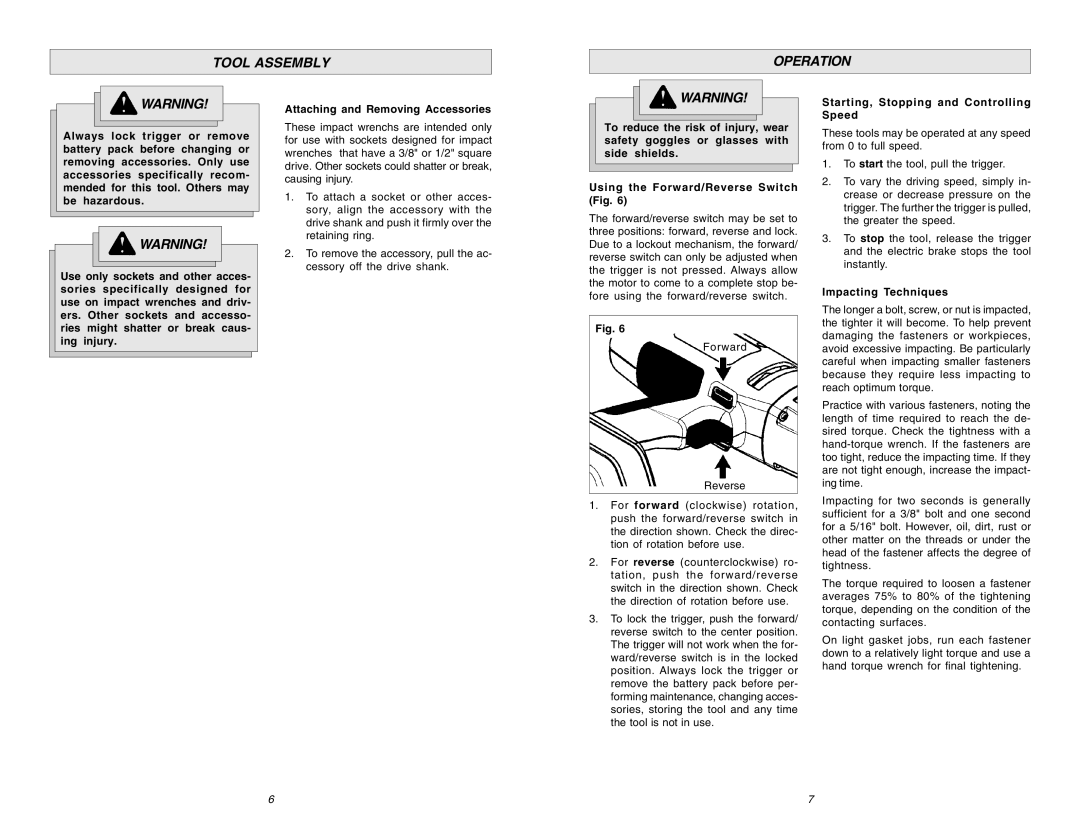
TOOL ASSEMBLY
OPERATION
![]() WARNING!
WARNING!
Always lock trigger or remove battery pack before changing or removing accessories. Only use accessories specifically recom-
Attaching and Removing Accessories
These impact wrenchs are intended only for use with sockets designed for impact wrenches that have a 3/8" or 1/2" square drive. Other sockets could shatter or break,
![]() WARNING!
WARNING!
To reduce the risk of injury, wear safety goggles or glasses with side shields.
Starting, Stopping and Controlling Speed
These tools may be operated at any speed from 0 to full speed.
1.To start the tool, pull the trigger.
mended for this tool. Others may be hazardous.
![]() WARNING!
WARNING!
Use only sockets and other acces- sories specifically designed for use on impact wrenches and driv- ers. Other sockets and accesso- ries might shatter or break caus- ing injury.
causing injury.
1.To attach a socket or other acces- sory, align the accessory with the drive shank and push it firmly over the retaining ring.
2.To remove the accessory, pull the ac- cessory off the drive shank.
Using the Forward/Reverse Switch (Fig. 6)
The forward/reverse switch may be set to three positions: forward, reverse and lock. Due to a lockout mechanism, the forward/ reverse switch can only be adjusted when the trigger is not pressed. Always allow the motor to come to a complete stop be- fore using the forward/reverse switch.
Fig. 6
Forward
Reverse
1.For forward (clockwise) rotation, push the forward/reverse switch in the direction shown. Check the direc- tion of rotation before use.
2.For reverse (counterclockwise) ro- tation, push the forward/reverse switch in the direction shown. Check the direction of rotation before use.
3.To lock the trigger, push the forward/ reverse switch to the center position. The trigger will not work when the for- ward/reverse switch is in the locked position. Always lock the trigger or remove the battery pack before per- forming maintenance, changing acces- sories, storing the tool and any time the tool is not in use.
2.To vary the driving speed, simply in- crease or decrease pressure on the trigger. The further the trigger is pulled, the greater the speed.
3.To stop the tool, release the trigger and the electric brake stops the tool instantly.
Impacting Techniques
The longer a bolt, screw, or nut is impacted, the tighter it will become. To help prevent damaging the fasteners or workpieces, avoid excessive impacting. Be particularly careful when impacting smaller fasteners because they require less impacting to reach optimum torque.
Practice with various fasteners, noting the length of time required to reach the de- sired torque. Check the tightness with a
Impacting for two seconds is generally sufficient for a 3/8" bolt and one second for a 5/16" bolt. However, oil, dirt, rust or other matter on the threads or under the head of the fastener affects the degree of tightness.
The torque required to loosen a fastener averages 75% to 80% of the tightening torque, depending on the condition of the contacting surfaces.
On light gasket jobs, run each fastener down to a relatively light torque and use a hand torque wrench for final tightening.
6
7
